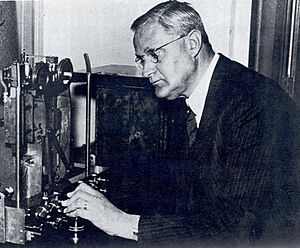Felix Andries Vening Meinesz facts for kids
Quick facts for kids
Felix Andries Vening Meinesz
|
|
|---|---|

Vening Meinesz with his gravimeter
|
|
| Born | 30 July 1887 |
| Died | 10 August 1966 (aged 79) |
| Nationality | Dutch |
| Known for | gravimeter |
| Awards | Howard N. Potts Medal (1936) Penrose Medal (1945) William Bowie Medal (1947) Alexander Agassiz Medal (1947) Vetlesen Prize (1962) Wollaston Medal (1963) |
| Scientific career | |
| Fields | geophysics geodesy |
| Influenced | H. H. Hess |
Felix Andries Vening Meinesz (born July 30, 1887 – died August 10, 1966) was a brilliant Dutch scientist. He studied the Earth's physical properties (geophysics) and its shape (geodesy). He is famous for inventing a super accurate way to measure gravity. This invention allowed scientists to measure gravity even in the middle of the ocean!
His work helped discover strange gravity patterns on the seafloor. He later realized these patterns were linked to how continents move around the Earth. He was also a Fellow of the Royal Society, a very respected group of scientists.
Contents
The Life of Felix Vening Meinesz
Felix Vening Meinesz was born in The Hague, Netherlands. His father was a mayor in important Dutch cities. Felix grew up in a supportive home. In 1910, he finished his studies in civil engineering in Delft. Soon after, he started working for the Dutch government, measuring gravity across the country.
Inventing a Better Gravimeter
In 1915, Felix wrote about problems with the tools used to measure gravity. These tools were called gravimeters. He then designed a brand new gravimeter. The Royal Dutch Meteorological Institute (KNMI) built his invention.
His new tool used two pendulums swinging in opposite directions. He found that if a boat moved, it didn't mess up the measurements. This meant he could measure gravity much more accurately. He first used it to map gravity all over the Netherlands. This was a big success!
Measuring Gravity at Sea
Because his new gravimeter worked so well on land, Felix wanted to try it at sea. He designed an even better version for this purpose. Between 1923 and 1929, the very tall Vening Meinesz went on several trips. He traveled in small submarines, which must have been quite uncomfortable!
His main goal was to figure out the exact shape of the Earth. In 1935, a movie was made about his expedition on the submarine Hr. Ms. K XVIII. This made him a hero to the Dutch public. His research also became famous around the world.
A Busy Professor
In 1927, he became a part-time professor at Utrecht University. He taught about geodesy, mapping (cartography), and geophysics. Later, in 1937, he also became a professor at the Delft University of Technology. He joined the Royal Netherlands Academy of Arts and Sciences in 1927. He also won several important awards for his work.
During World War II, Vening Meinesz helped the Dutch resistance. After the war, he returned to his teaching jobs. He also led the KNMI from 1945 to 1951. He retired in 1957 and passed away in Amersfoort in 1966.
Discoveries About Earth's Gravity
Felix Vening Meinesz collected huge amounts of gravity data from his expeditions. He worked with other top Dutch Earth scientists to study this information. They published their findings in 1948.
Gravity Anomalies
One important discovery was finding long belts of "negative gravity anomalies" near ocean trenches. A gravity anomaly is a place where gravity is stronger or weaker than expected. Negative anomalies mean gravity is weaker.
He noticed that the average gravity on land and at sea was about the same. This matched a principle called isostasy. Isostasy means that Earth's crust floats on the mantle, like icebergs in water.
Understanding Earth's Crust
Vening Meinesz was very interested in ocean trenches. These are very deep parts of the ocean floor. He saw that active volcanoes, weak gravity, and sudden changes in land height often happened together there. He thought this meant the Earth's outer layer, called the crust, was being squeezed together in these spots.
At first, scientists thought the Earth's crust was too stiff to bend that much. But his discoveries helped lead to the theory of plate tectonics in the 1950s. This theory explains how the Earth's crust is broken into large plates that move and crash into each other.
Submarine Expeditions
Vening Meinesz used his special pendulum tool on many submarines to measure Earth's gravity. His adventures are written about in his books, "Gravity Expeditions at Sea."
Early Expeditions (1923–1930)
- HNLMS K II (1923)
- HNLMS K XI (1925)
- HNLMS K XIII (1926–1927)
- HNLMS K XIII (1928–1930)
More Journeys (1932–1939)
- HNLMS O 13 (1932)
- HNLMS K XVIII (1934–1935)
- HNLMS O 16 (1937)
- HNLMS O 12 (1937)
- HNLMS O 13 (1938)
- HNLMS O 19 (1939)
After 1939, Vening Meinesz no longer went on the expeditions himself. His students continued his important work.
Later Expeditions (1948–1958)
- HNLMS O 24 (1948 - 1949)
- HNLMS Tijgerhaai (1951)
- HNLMS Walrus (1957)
- HNLMS Vos (1955)
- HNLMS Zeeleeuw (1956)
- HNLMS Fret (1957)
Felix Vening Meinesz's Legacy
Many things are named after Felix Vening Meinesz to honor his contributions:
- A type of gravimeter, the tool he invented to measure gravity.
- A mathematical function used in the study of Earth's shape.
- A medal given by the European Geosciences Union to top scientists.
- A research school at Utrecht University.
- A crater on the Moon is named Vening Meinesz.
See also
- List of geophysicists

